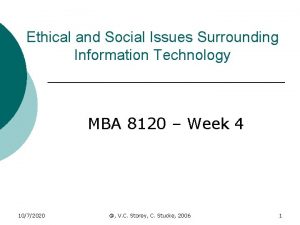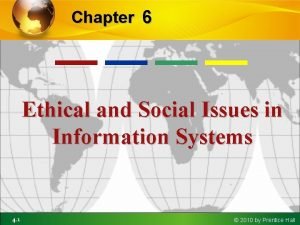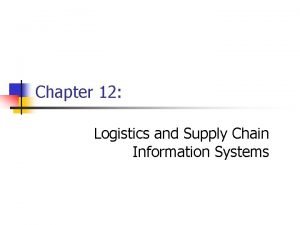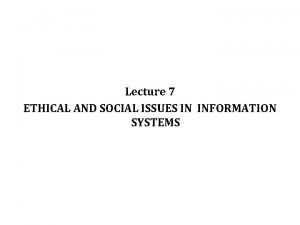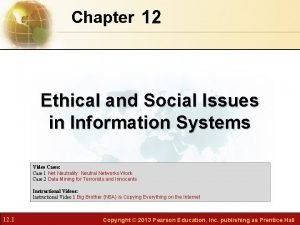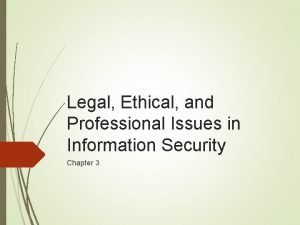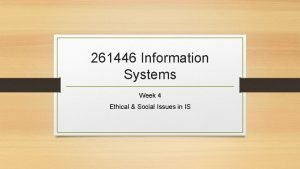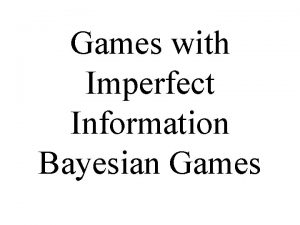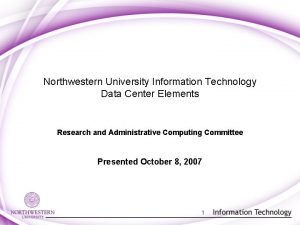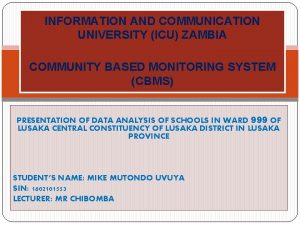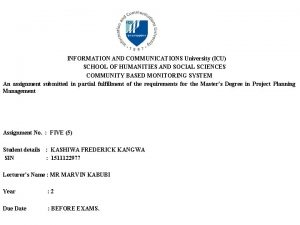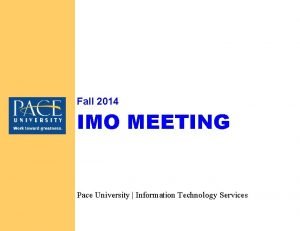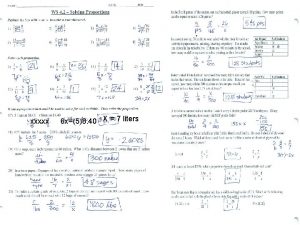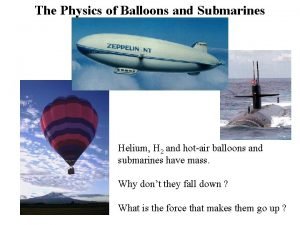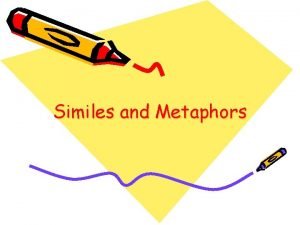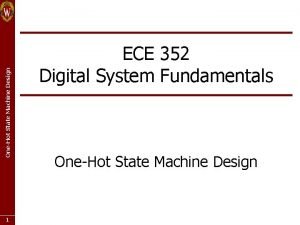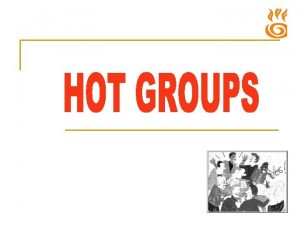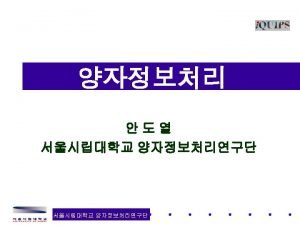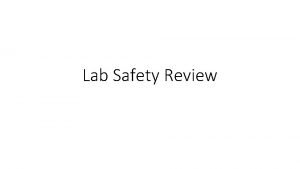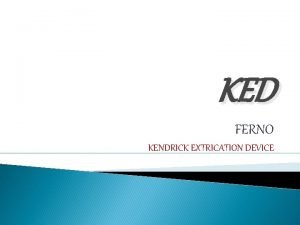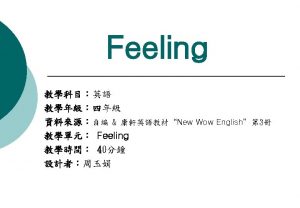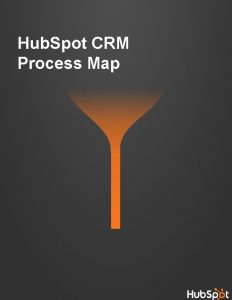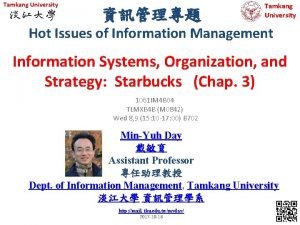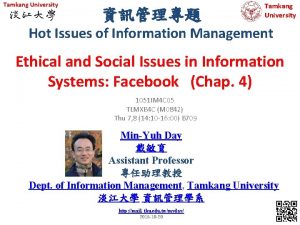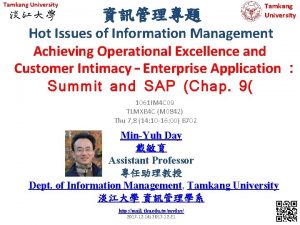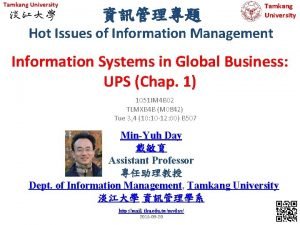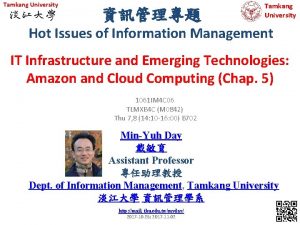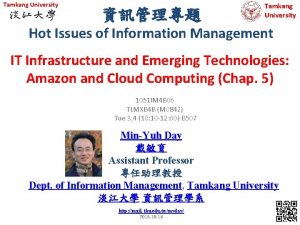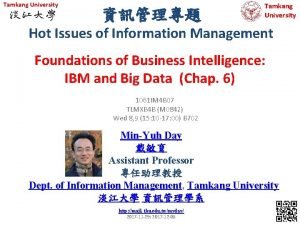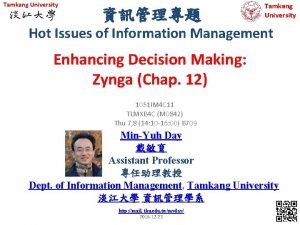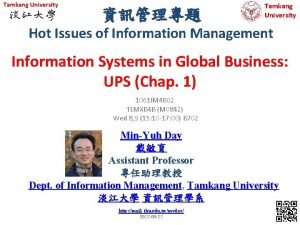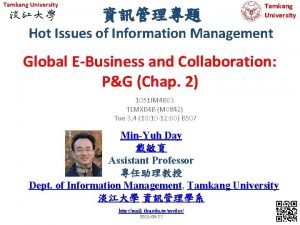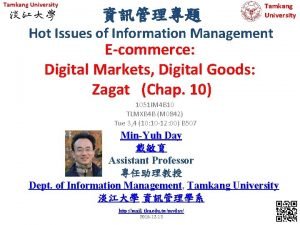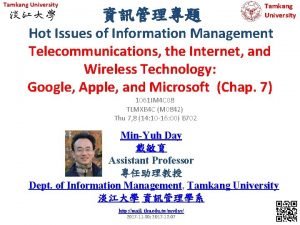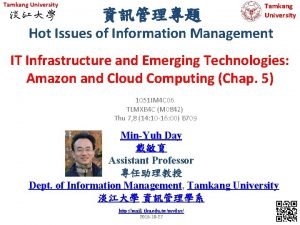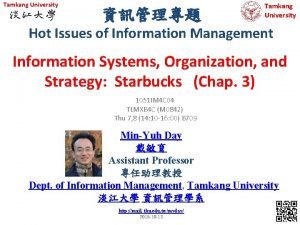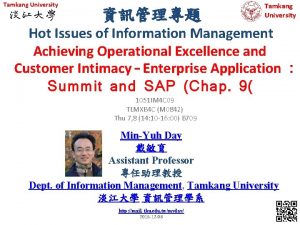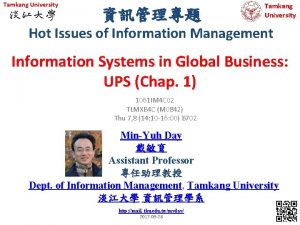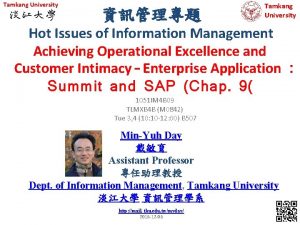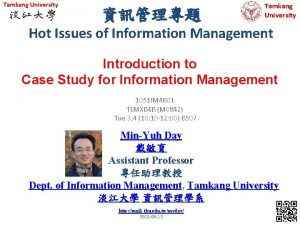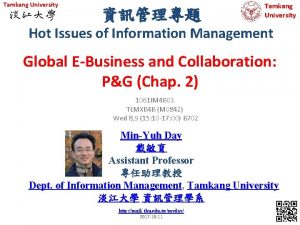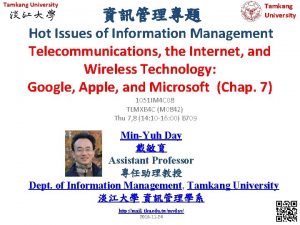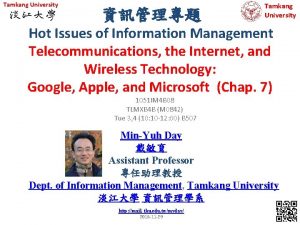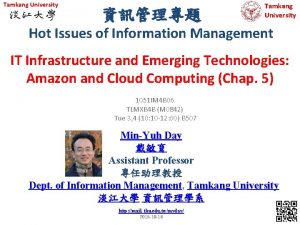Tamkang University Tamkang University Hot Issues of Information





























































- Slides: 61

Tamkang University 資訊管理專題 Tamkang University Hot Issues of Information Management Introduction to Case Study for Information Management 1051 IM 4 C 01 TLMXB 4 C (M 0842) Thu 7, 8 (14: 10 -16: 00) B 607 Min-Yuh Day 戴敏育 Assistant Professor 專任助理教授 Dept. of Information Management, Tamkang University 淡江大學 資訊管理學系 http: //mail. tku. edu. tw/myday/ 2016 -09 -22 1


Information Management (MIS) Information Systems Source: Kenneth C. Laudon & Jane P. Laudon (2014), Management Information Systems: Managing the Digital Firm, Thirteenth Edition, Pearson. 3

Overview of Fundamental MIS Concepts Business Challenges Management Organization Information System Business Solutions Technology Source: Kenneth C. Laudon & Jane P. Laudon (2014), Management Information Systems: Managing the Digital Firm, Thirteenth Edition, Pearson. 4

Management Information Systems: Managing the Digital Firm 1 2 3 4 Organization, Management, and the Networked Enterprise Information Technology Infrastructure Key System Applications for the Digital Age Building and Managing Systems Source: Kenneth C. Laudon & Jane P. Laudon (2014), Management Information Systems: Managing the Digital Firm, Thirteenth Edition, Pearson. 5


Course Introduction • This course helps students to understand analysis the direct connection between information systems and business performance though case study of information management hot topics. • It helps students a better understanding of how specific companies use information systems to achieve the main business objectives: – – – operational excellence new products, services, and business models customer and supplier intimacy improved decision making competitive advantage survival 7


Objective • Student will be able to understand apply the methods of case study for information management hot topics. 9

課程大綱 (Syllabus) 週次 (Week) 日期 (Date) 內容 (Subject/Topics) 1 2016/09/15 中秋節 (放假一天) (Mid-Autumn Festival)(Day off) 2 2016/09/22 Introduction to Case Study for Information Management Hot Topics 3 2016/09/29 Information Systems in Global Business: UPS (Chap. 1) (pp. 53 -54) 4 2016/10/06 Global E-Business and Collaboration: P&G (Chap. 2) (pp. 84 -85) 5 2016/10/13 Information Systems, Organization, and Strategy: Starbucks (Chap. 3) (pp. 129 -130) 6 2016/10/20 Ethical and Social Issues in Information Systems: Facebook (Chap. 4) (pp. 188 -190) 10

課程大綱 (Syllabus) 週次 (Week) 日期 (Date) 內容 (Subject/Topics) 7 2016/10/27 IT Infrastructure and Emerging Technologies: Amazon and Cloud Computing (Chap. 5) (pp. 234236) 8 2016/11/03 Foundations of Business Intelligence: IBM and Big Data (Chap. 6) (pp. 261 -262) 9 2016/11/10 Midterm Report (期中報告) 10 2016/11/17 期中考試週 11 2016/11/24 Telecommunications, the Internet, and Wireless Technology: Google, Apple, and Microsoft (Chap. 7) (pp. 318 -320) 12 2016/12/01 Enterprise Applications: Summit and SAP (Chap. 9) (pp. 396 -398) 11

課程大綱 (Syllabus) 週次 日期 內容(Subject/Topics) 13 2016/12/08 E-commerce: Zagat (Chap. 10) (pp. 443 -445) 14 2016/12/15 Enhancing Decision Making: Zynga (Chap. 12) (pp. 512 -514) 15 2016/12/22 Managing Projects: NYCAPS and City. Time (Chap. 14) (pp. 586 -588) 16 2016/12/29 Final Report I (期末報告 I) 17 2017/01/05 Final Report II (期末報告 II) 18 2017/01/12 期末考試週 12

教材課本與參考書籍 • 教材課本 (Textbook) • Kenneth C. Laudon & Jane P. Laudon (2014), Management Information Systems: Managing the Digital Firm, Thirteenth Edition, Pearson. – 參考書籍 (References) • Kenneth C. Laudon & Jane P. Laudon原著, 游張松 主編,陳文生 翻譯 (2014), 資訊管理系統,第 13版,滄海 13



Case Study 16

Case Study • Harvard Business School – The Case Method at HBS – Inside the Case Method: The Entrepreneurial Manager • http: //www. youtube. com/watch? v=YWyb. EVs. Vwe 4 (15: 56) Source: http: //www. youtube. com/watch? v=YWyb. EVs. Vwe 4 17

Information Management (MIS) Information Systems Source: Kenneth C. Laudon & Jane P. Laudon (2014), Management Information Systems: Managing the Digital Firm, Thirteenth Edition, Pearson. 18

Overview of Fundamental MIS Concepts Business Challenges Management Organization Information System Business Solutions Technology Source: Kenneth C. Laudon & Jane P. Laudon (2014), Management Information Systems: Managing the Digital Firm, Thirteenth Edition, Pearson. 19

Management Information Systems: Managing the Digital Firm 1 2 3 4 Organization, Management, and the Networked Enterprise Information Technology Infrastructure Key System Applications for the Digital Age Building and Managing Systems Source: Kenneth C. Laudon & Jane P. Laudon (2014), Management Information Systems: Managing the Digital Firm, Thirteenth Edition, Pearson. 20

Business Model 21

Business Model 8 6 2 4 Key Activities Key Partners 7 Customer Relationships Value Proposition Key Resources 9 Cost Structure 1 Customer Segments 3 Channels 5 Revenue Streams Source: Alexander Osterwalder & Yves Pigneur, Business Model Generation: A Handbook for Visionaries, Game Changers, and Challengers, Wiley, 2010. 22

Definition of Business Model A business model describes the rationale of how an organization creates, delivers, and captures value. Source: Alexander Osterwalder & Yves Pigneur, Business Model Generation: A Handbook for Visionaries, Game Changers, and Challengers, Wiley, 2010. 23

Business Model Canvas Key Activities Key Partners Customer Relationships Value Preposition Customer Segments Key Resources Channels Cost Structure Revenue Streams Source: http: //nonlinearthinking. typepad. com/nonlinear_thinking/2008/07/the-business-model-canvas. html https: //www. youtube. com/watch? v=Qo. AOz. MTLP 5 s 24

Business Model Canvas Infrastructure Management Key Product Activities Key Partners Customer Relationships Value Preposition Key Resources Financial Cost Aspects Structure Customer Interface Customer Segments Channels Revenue Streams Source: http: //nonlinearthinking. typepad. com/nonlinear_thinking/2008/07/the-business-model-canvas. html https: //www. youtube. com/watch? v=Qo. AOz. MTLP 5 s 25

Business Model Canvas Explained Source: http: //www. youtube. com/watch? v=Qo. AOz. MTLP 5 s 26

The 9 Building Blocks of Business Model 8 6 7 9 2 4 1 3 5 Source: Alexander Osterwalder & Yves Pigneur, Business Model Generation: A Handbook for Visionaries, Game Changers, and Challengers, Wiley, 2010. 27

Case Study: UPS (Chap. 1) (pp. 53 -54) UPS Competes Globally with Information Technology Source: Kenneth C. Laudon & Jane P. Laudon (2014), Management Information Systems: Managing the Digital Firm, Thirteenth Edition, Pearson. 28

Ponsse: Efficiency in Wood Harvesting with Information System Source: http: //www. ponsse. com/ Source: Kenneth C. Laudon & Jane P. Laudon (2014), Management Information Systems: Managing the Digital Firm, Thirteenth Edition, Pearson. 29

Overview of Fundamental MIS Concepts using an integrated framework for describing and analyzing information systems Business Challenges • Develop new production processes • Develop new management techniques • Increase use of data by managers Management • • • New sources of competition Declining customer base Increasing costs • Build new business production processes • Train new channels of information flow • Train employee in use of the systems • Develop GPS systems for field use • Create email links with operators • Develop data base to receive information Organization Information System Business Solutions • Optimize • Display and report Technology GPS location data • Reports on production • Provide online coordination utilization of forests • Increase production efficiency • Coordinate production process Source: Kenneth C. Laudon & Jane P. Laudon (2014), Management Information Systems: Managing the Digital Firm, Thirteenth Edition, Pearson. 30

Information Systems in Global Business 1. How are information systems transforming business and what is their relationship to globalization? 2. Why are information systems so essential for running and managing a business today? 3. What exactly is an information system? How does it work? What are its management, organization, and technology components? 4. What are complementary assets? Why are complementary assets essential for ensuring that information systems provide genuine value for an organization? 5. What academic disciplines are used to study information systems? How does each contribute to an understanding of information systems? What is a sociotechnical systems perspective? Source: Kenneth C. Laudon & Jane P. Laudon (2014), Management Information Systems: Managing the Digital Firm, Thirteenth Edition, Pearson. 31

How information systems are transforming business • Emerging mobile digital platform • Growing business use of “big data” • Growth in cloud computing Source: Kenneth C. Laudon & Jane P. Laudon (2014), Management Information Systems: Managing the Digital Firm, Thirteenth Edition, Pearson. 32

Globalization opportunities • Internet has drastically reduced costs of operating on global scale • Increases in foreign trade, outsourcing • Presents both challenges and opportunities Source: Kenneth C. Laudon & Jane P. Laudon (2014), Management Information Systems: Managing the Digital Firm, Thirteenth Edition, Pearson. 33

The Interdependence Between Organizations and Information Technology Source: Kenneth C. Laudon & Jane P. Laudon (2014), Management Information Systems: Managing the Digital Firm, Thirteenth Edition, Pearson. 34

Strategic Business Objectives of Information Systems 1. 2. 3. 4. 5. 6. Operational Excellence New Products, Services and Business Models Customer and Supplier Intimacy Improved Decision Making Competitive Advantage Survival Source: Kenneth C. Laudon & Jane P. Laudon (2014), Management Information Systems: Managing the Digital Firm, Thirteenth Edition, Pearson. 35

1. Operational Excellence • Improvement of efficiency to attain higher profitability • Information systems, technology an important tool in achieving greater efficiency and productivity • Walmart’s Retail Link system links suppliers to stores for superior replenishment system Source: Kenneth C. Laudon & Jane P. Laudon (2014), Management Information Systems: Managing the Digital Firm, Thirteenth Edition, Pearson. 36

2. New Products, Services, and Business Models • Business model: describes how company produces, delivers, and sells product or service to create wealth • Information systems and technology a major enabling tool for new products, services, business models – Examples: Apple’s i. Pad, Google’s Android OS, and Netflix Source: Kenneth C. Laudon & Jane P. Laudon (2014), Management Information Systems: Managing the Digital Firm, Thirteenth Edition, Pearson. 37

3. Customer and Supplier Intimacy • Serving customers well leads to customers returning, which raises revenues and profits. – Example: High-end hotels that use computers to track customer preferences and used to monitor and customize environment • Intimacy with suppliers allows them to provide vital inputs, which lowers costs. – Example: JCPenney’s information system which links sales records to contract manufacturer Source: Kenneth C. Laudon & Jane P. Laudon (2014), Management Information Systems: Managing the Digital Firm, Thirteenth Edition, Pearson. 38

4. Improved Decision Making • Without accurate information: – Managers must use forecasts, best guesses, luck – Results in: • Overproduction, underproduction • Misallocation of resources • Poor response times – Poor outcomes raise costs, lose customers • Example: – Verizon’s Web-based digital dashboard to provide managers with real-time data on customer complaints, network performance, line outages Source: Kenneth C. Laudon & Jane P. Laudon (2014), Management Information Systems: Managing the Digital Firm, Thirteenth Edition, Pearson. 39

5. Competitive advantage • Delivering better performance • Charging less for superior products • Responding to customers and suppliers in real time • Examples: Apple, Walmart, UPS Source: Kenneth C. Laudon & Jane P. Laudon (2014), Management Information Systems: Managing the Digital Firm, Thirteenth Edition, Pearson. 40

6. Survival • Information technologies as necessity of business • Industry-level changes – Example: Citibank’s introduction of ATMs • Governmental regulations requiring recordkeeping – Examples: Toxic Substances Control Act, Sarbanes. Oxley Act Source: Kenneth C. Laudon & Jane P. Laudon (2014), Management Information Systems: Managing the Digital Firm, Thirteenth Edition, Pearson. 41

Information Systems Are More Than Computers Source: Kenneth C. Laudon & Jane P. Laudon (2014), Management Information Systems: Managing the Digital Firm, Thirteenth Edition, Pearson. 42

Dimensions of Information Systems • Organizations – People, structure, business processes, politics, and culture. • Management – Make sense out of the many situations faced by organizations, make decisions, and formulate action plans to solve organizational problems. • Information Technology – Computer hardware, software, data management technology, networking and telecommunications technology Source: Kenneth C. Laudon & Jane P. Laudon (2014), Management Information Systems: Managing the Digital Firm, Thirteenth Edition, Pearson. 43

Perspectives on Information Systems: Data and Information Source: Kenneth C. Laudon & Jane P. Laudon (2014), Management Information Systems: Managing the Digital Firm, Thirteenth Edition, Pearson. 44

Functions of an Information System Source: Kenneth C. Laudon & Jane P. Laudon (2014), Management Information Systems: Managing the Digital Firm, Thirteenth Edition, Pearson. 45

Levels in a Firm Source: Kenneth C. Laudon & Jane P. Laudon (2014), Management Information Systems: Managing the Digital Firm, Thirteenth Edition, Pearson. 46

MAJOR BUSINESS FUNCTION PURPOSE Sales and marketing Selling the organization’s products and services Manufacturing and production Producing and delivering products and services Finance and accounting Managing the organization’s financial assets and maintaining the organization’s financial records Human resources Attracting, developing, and maintaining the organization’s labor force; maintaining employee records Source: Kenneth C. Laudon & Jane P. Laudon (2014), Management Information Systems: Managing the Digital Firm, Thirteenth Edition, Pearson. 47

IT ISN’T JUST TECHNOLOGY: A BUSINESS PERSPECTIVE ON INFORMATION SYSTEMS Source: Kenneth C. Laudon & Jane P. Laudon (2014), Management Information Systems: Managing the Digital Firm, Thirteenth Edition, Pearson. 48

The Business Information Value Chain Source: Kenneth C. Laudon & Jane P. Laudon (2014), Management Information Systems: Managing the Digital Firm, Thirteenth Edition, Pearson. 49

The Business Information Value Chain • From a business perspective, information systems are part of a series of value-adding activities for acquiring, transforming, and distributing information that managers can use to improve decision making, enhance organizational performance, and, ultimately, increase firm profitability. Source: Kenneth C. Laudon & Jane P. Laudon (2014), Management Information Systems: Managing the Digital Firm, Thirteenth Edition, Pearson. 50

COMPLEMENTARY SOCIAL, MANAGERIAL, AND ORGANIZATIONAL ASSETS REQUIRED TO OPTIMIZE RETURNS FROM INFORMATION TECHNOLOGY INVESTMENTS Source: Kenneth C. Laudon & Jane P. Laudon (2014), Management Information Systems: Managing the Digital Firm, Thirteenth Edition, Pearson. 51

Organizational assets • Supportive organizational culture that values efficiency and effectiveness • Appropriate business model • Efficient business processes • Decentralized authority • Distributed decision-making rights • Strong IS development team Source: Kenneth C. Laudon & Jane P. Laudon (2014), Management Information Systems: Managing the Digital Firm, Thirteenth Edition, Pearson. 52

Managerial assets • Strong senior management support for technology investment and change • Incentives for management innovation • Teamwork and collaborative work environments • Training programs to enhance management decision skills • Management culture that values flexibility and knowledge-based decision making. Source: Kenneth C. Laudon & Jane P. Laudon (2014), Management Information Systems: Managing the Digital Firm, Thirteenth Edition, Pearson. 53

Social assets • The Internet and telecommunications infrastructure • IT-enriched educational programs raising labor force computer literacy • Standards (both government and private sector) • Laws and regulations creating fair, stable market environments • Technology and service firms in adjacent markets to assist implementation Source: Kenneth C. Laudon & Jane P. Laudon (2014), Management Information Systems: Managing the Digital Firm, Thirteenth Edition, Pearson. 54

Contemporary Approaches to Information Systems Source: Kenneth C. Laudon & Jane P. Laudon (2014), Management Information Systems: Managing the Digital Firm, Thirteenth Edition, Pearson. 55

Contemporary Approaches to Information Systems • Technical Approach • Behavioral Approach • Sociotechnical Systems Source: Kenneth C. Laudon & Jane P. Laudon (2014), Management Information Systems: Managing the Digital Firm, Thirteenth Edition, Pearson. 56

A Sociotechnical Perspective on Information Systems Source: Kenneth C. Laudon & Jane P. Laudon (2014), Management Information Systems: Managing the Digital Firm, Thirteenth Edition, Pearson. 57

Case Study: UPS (Chap. 1) (pp. 53 -54) UPS Competes Globally with Information Technology 1. What are the inputs, processing, and outputs of UPS’s package tracking system? 2. What technologies are used by UPS? How are these technologies related to UPS’s business strategy? 3. What strategic business objectives do UPS’s information systems address? 4. What would happen if UPS’s information systems were not available? 58


Summary • This course helps students to understand analysis the direct connection between information systems and business performance though case study of information management hot topics. • It helps students a better understanding of how specific companies use information systems to achieve the main business objectives: – – – operational excellence new products, services, and business models customer and supplier intimacy improved decision making competitive advantage survival 60

Contact Information 戴敏育 博士 (Min-Yuh Day, Ph. D. ) 專任助理教授 淡江大學 資訊管理學系 電話: 02 -26215656 #2846 傳真: 02 -26209737 研究室:B 929 地址: 25137 新北市淡水區英專路 151號 Email: myday@mail. tku. edu. tw 網址:http: //mail. tku. edu. tw/myday/ 61
 White hot vs red hot temperature
White hot vs red hot temperature Advantages of hot working over cold working
Advantages of hot working over cold working Perbedaan hot lava dan hot lava volcano
Perbedaan hot lava dan hot lava volcano Be either hot or cold
Be either hot or cold Professional issues in information security
Professional issues in information security Social issues in information technology
Social issues in information technology Professional issues in information system
Professional issues in information system Ethical and social issues in information systems doc
Ethical and social issues in information systems doc Legal ethical and societal issues in media and information
Legal ethical and societal issues in media and information Chapter 4 ethical and social issues in information systems
Chapter 4 ethical and social issues in information systems Contemporary issues in information systems
Contemporary issues in information systems Information about social issues
Information about social issues Information about social issues
Information about social issues Legal and ethical issues in information security
Legal and ethical issues in information security Chapter 4 ethical and social issues in information systems
Chapter 4 ethical and social issues in information systems Ethical and social issues in information systems
Ethical and social issues in information systems Imperfect vs incomplete information
Imperfect vs incomplete information Northwestern university information technology
Northwestern university information technology Emphancy
Emphancy Tashkent university of information technology
Tashkent university of information technology Department of information engineering university of padova
Department of information engineering university of padova Department of information engineering university of padova
Department of information engineering university of padova List of lecturers at icu zambia
List of lecturers at icu zambia Pace university information technology
Pace university information technology 沈榮麟
沈榮麟 Hotpack kontrendikasyonları
Hotpack kontrendikasyonları Xxxxx6x
Xxxxx6x Hot air oven
Hot air oven Why is las vegas so hot
Why is las vegas so hot Proper storing of sandwiches
Proper storing of sandwiches Osha hot work standard
Osha hot work standard Coil visbreaking
Coil visbreaking Erdes hot
Erdes hot What keeps the sun hot
What keeps the sun hot Balloons
Balloons A hot summer day fox and goat story
A hot summer day fox and goat story Hot 3257 tanker
Hot 3257 tanker Keno sushi
Keno sushi Solar hotdog cooker
Solar hotdog cooker Brianna jordan hot
Brianna jordan hot Colors of stars from coolest to hottest
Colors of stars from coolest to hottest Similes as hot as
Similes as hot as Cold war hot spots
Cold war hot spots Viv root word
Viv root word Hot cold empathy gap
Hot cold empathy gap Hot and cold dessert ppt
Hot and cold dessert ppt Bayonet charge key quotes
Bayonet charge key quotes One hot state assignment
One hot state assignment Hot group
Hot group Given δpqr and δstu, what is m∠q?
Given δpqr and δstu, what is m∠q? Hot carrier 효과
Hot carrier 효과 Learning outcomes of empathy
Learning outcomes of empathy Why is the inside of the earth hot
Why is the inside of the earth hot If an acid is splashed on your skin, wash at once with
If an acid is splashed on your skin, wash at once with Puding kontinental
Puding kontinental Pengertian dapur hotel
Pengertian dapur hotel Ked strap order
Ked strap order Cased crossing pipeline
Cased crossing pipeline Hot or not composite images
Hot or not composite images Hungry sad
Hungry sad Hop spot crm
Hop spot crm Topics in sports nutrition
Topics in sports nutrition





